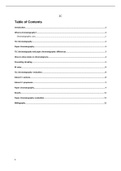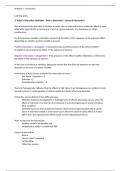Table of Contents
Introduction.................................................................................................................................................. 2
What is chromatography?............................................................................................................................. 2
Chromatography: uses.........................................................................................................................................2
TLC chromatography..................................................................................................................................... 2
Paper chromatography................................................................................................................................. 3
TLC chromatography and paper chromatography: differences.......................................................................3
Ways to show stains on chromatograms....................................................................................................... 4
Preventing streaking..................................................................................................................................... 5
Rf value........................................................................................................................................................ 8
TLC chromatography: evaluation................................................................................................................... 8
Solvent 1: acetone........................................................................................................................................ 8
Solvent 2: propanone.................................................................................................................................... 9
Paper chromatography................................................................................................................................. 9
Results........................................................................................................................................................ 11
Paper chromatography: evaluation............................................................................................................. 11
Bibliography............................................................................................................................................... 12
1
, Introduction
In this report I will be using chromatographic techniques in order to
identify different components in mixtures. I’ll be evaluating and analysing
these techniques and how I can use them effectively in order to achieve
the most accurate and reliable results possible.
What is chromatography?
Chromatography is a separation procedure that divides a mixture into two
phases. The stationary phase remains put while the mobile phase
distributes the mixture's components through the medium. Many of the
components in a mixture are constrained by the stationary phase, which
causes them to move more slowly than the mobile phase. The importance
of the components' interactions with the mobile and/or stationary phases
controls their mobility in the mobile phase. The basic idea behind
chromatography is that we have a mixture in one state of matter, such as
a gas or liquid, traveling over the surface of another state of matter that
remains stationary. The mobile phase is made up of moving substances,
while the stationary phase is made up of stationary substances. The
stationary phase divides the mobile phase into its components as it
moves. Some components will move quicker than others due to
differences in factors such as their solubility in the mobile phase and the
strength of their affinities for the stationary phase, making separation of
the components within that mixture easier.
Key terminology
- Mobile phase: the phase of the solvent moving through the column.
- Stationary phase: the substance that remains within the column.
- Adsorption: the accumulation of a substance on the surface of
another material forming a thin layer/film as a result.
Chromatography: uses
By transferring the device's output into a detector that reads the contents
of the mixture, chromatography can be used as an analytical technique. It
can also be used to purify a mixture, isolating the constituents for future
research or therapy. Chromatography separates and analyses additives,
vitamins, preservatives, proteins, and amino acids for quality control in
the food sector. It may also detect and separate pollutants like aflatoxin, a
cancer-causing substance. Chromatography can be used for a variety of
things, from detecting drug molecules in urine or other bodily fluids to
detecting combustible chemical traces in burnt material from possible
arson locations. Gas chromatography, liquid chromatography, thin-layer
chromatography (TLC), paper chromatography, and ion exchange
chromatography are all examples of chromatography techniques.
TLC chromatography
TLC is a straightforward, rapid, and low-cost method for determining how
many components are present in a mixture. When the Rf of a chemical is
compared to the Rf of a known compound, TLC can be used to support the
identity of the compound in a mixture. A TLC plate is a thin layer of solid
adsorbent deposited on a sheet of glass, metal, or plastic, usually silica or
2











